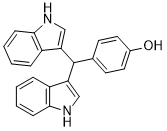DIM-C-pPhOH (also known as C-DIM8) is a Nur77 (NR4A1) antagonist. In a metastasis model, DIM-C-pPhOH prevents the growth of lung cancer cells and tumors. When pancreatic and colon cancer cells are treated with C-DIM8, it mimics the effects of NR4A1 knockdown and lowers the expression of β1-integrin, as well as β1-integrin-regulated genes and responses, such as migration and adhesion. A member of the nuclear receptor family of transcription factors' nerve growth factor-I-B subfamily, Nur77 is an orphan receptor. The findings show a fresh approach for β1-integrin targeting in pancreatic and colon cancer cells and suggest potential clinical uses for C-DIM/NR4A1 antagonists in the treatment of colon and pancreatic cancer.
Physicochemical Properties
| Molecular Formula | C23H18N2O | |
| Molecular Weight | 338.41 | |
| Exact Mass | 338.141 | |
| Elemental Analysis | C, 81.63; H, 5.36; N, 8.28; O, 4.73 | |
| CAS # | 151358-47-3 | |
| Related CAS # |
|
|
| PubChem CID | 2940609 | |
| Appearance | Off-white to pink solid powder | |
| Density | 1.3±0.1 g/cm3 | |
| Boiling Point | 610.2±50.0 °C at 760 mmHg | |
| Flash Point | 322.9±30.1 °C | |
| Vapour Pressure | 0.0±1.8 mmHg at 25°C | |
| Index of Refraction | 1.770 | |
| LogP | 4.8 | |
| Hydrogen Bond Donor Count | 3 | |
| Hydrogen Bond Acceptor Count | 1 | |
| Rotatable Bond Count | 3 | |
| Heavy Atom Count | 26 | |
| Complexity | 443 | |
| Defined Atom Stereocenter Count | 0 | |
| SMILES | O([H])C1C([H])=C([H])C(=C([H])C=1[H])C([H])(C1=C([H])N([H])C2=C([H])C([H])=C([H])C([H])=C12)C1=C([H])N([H])C2=C([H])C([H])=C([H])C([H])=C12 |
|
| InChi Key | QCPDFNWJBQMXLI-UHFFFAOYSA-N | |
| InChi Code | InChI=1S/C23H18N2O/c26-16-11-9-15(10-12-16)23(19-13-24-21-7-3-1-5-17(19)21)20-14-25-22-8-4-2-6-18(20)22/h1-14,23-26H | |
| Chemical Name | 4-[bis(1H-indol-3-yl)methyl]phenol | |
| Synonyms |
|
|
| HS Tariff Code | 2934.99.9001 | |
| Storage |
Powder-20°C 3 years 4°C 2 years In solvent -80°C 6 months -20°C 1 month |
|
| Shipping Condition | Room temperature (This product is stable at ambient temperature for a few days during ordinary shipping and time spent in Customs) |
Biological Activity
| Targets | Nur77 (IC50 = 13.0 μM); Nur77 (IC50 = 13.6 μM) |
| ln Vitro |
DIM-C-pPhOH (7.5-20 μM; 24 hours; ACHN and 786-O cells) treatment significantly decreases cell proliferation[1]. DIM-C-pPhOH (20 μM; 24 hours; ACHN and 786-O cells) treatment results in Annexin V staining in ACHN and 786-O cells, confirming that DIM-C-pPhOH induces apoptosis and also induces caspase 7 and 8 cleavage[1]. DIM-C-pPhOH (15-20 μM; 24 hours; ACHN and 786-O cells) treatment inhibits NR4A1-regulated expression of survivin, bcl-2 and EGFR in ACHN and 786-O cells. Additionally, it activates AMPK, stimulates sestrin 2, and inhibits the activation of mTOR and downstream kinases[1]. DIM-C-pPhOH reduces expression of β1-integrin protein and mRNA as well as β1-integrin-dependent responses in MCF7, MDA-MB-231, and SKBR3. The latter two cell lines are also prevented from migrating[2]. |
| ln Vivo | DIM-C-pPhOH (30 mg/kg; oral gavage; daily; for 50 days; male athymic nude mice) treatment results in a significant inhibition of tumor growth[1]. |
| References |
[1]. Nuclear Receptor 4A1 (NR4A1) as a Drug Target for Renal Cell Adenocarcinoma. PLoS One. 2015 Jun 2;10(6):e0128308. [2]. NR4A1 Antagonists Inhibit β1-Integrin-Dependent Breast Cancer Cell Migration. Mol Cell Biol. 2016 Apr 15;36(9):1383-94. |
Solubility Data
| Solubility (In Vitro) |
DMSO: 68~125 mg/mL(201.0~369.4 mM) |
| Solubility (In Vivo) |
Solubility in Formulation 1: ≥ 2.08 mg/mL (6.15 mM) (saturation unknown) in 10% DMSO + 40% PEG300 + 5% Tween80 + 45% Saline (add these co-solvents sequentially from left to right, and one by one), clear solution. For example, if 1 mL of working solution is to be prepared, you can add 100 μL of 20.8 mg/mL clear DMSO stock solution to 400 μL PEG300 and mix evenly; then add 50 μL Tween-80 to the above solution and mix evenly; then add 450 μL normal saline to adjust the volume to 1 mL. Preparation of saline: Dissolve 0.9 g of sodium chloride in 100 mL ddH₂ O to obtain a clear solution. Solubility in Formulation 2: ≥ 2.08 mg/mL (6.15 mM) (saturation unknown) in 10% DMSO + 90% (20% SBE-β-CD in Saline) (add these co-solvents sequentially from left to right, and one by one), clear solution. For example, if 1 mL of working solution is to be prepared, you can add 100 μL of 20.8 mg/mL clear DMSO stock solution to 900 μL of 20% SBE-β-CD physiological saline solution and mix evenly. Preparation of 20% SBE-β-CD in Saline (4°C,1 week): Dissolve 2 g SBE-β-CD in 10 mL saline to obtain a clear solution. Solubility in Formulation 3: ≥ 2.08 mg/mL (6.15 mM) (saturation unknown) in 10% DMSO + 90% Corn Oil (add these co-solvents sequentially from left to right, and one by one), clear solution. For example, if 1 mL of working solution is to be prepared, you can add 100 μL of 20.8 mg/mL clear DMSO stock solution to 900 μL of corn oil and mix evenly. (Please use freshly prepared in vivo formulations for optimal results.) |
| Preparing Stock Solutions | 1 mg | 5 mg | 10 mg | |
| 1 mM | 2.9550 mL | 14.7750 mL | 29.5500 mL | |
| 5 mM | 0.5910 mL | 2.9550 mL | 5.9100 mL | |
| 10 mM | 0.2955 mL | 1.4775 mL | 2.9550 mL |
